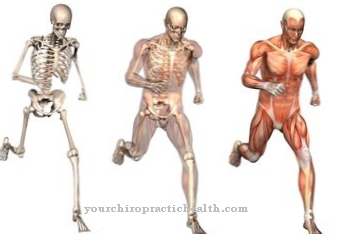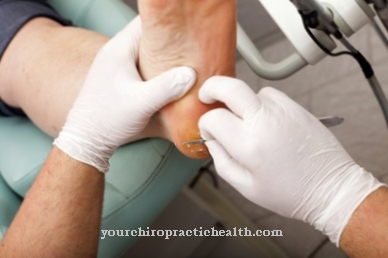Menstrual cycle disorders, Menstrual irregularities or Menstrual cramps are symptomatic disorders of the woman's healthy cycle.
What are menstrual cycle disorders?

First of all, it should be clarified what menstrual disorders or menstrual cramps actually are. Deviations from the normal monthly cycle of a woman are called menstrual disorders. Either the interval between menstruation or the strength of the bleeding are changed.
Other deviations can be the absence of menstrual bleeding, known as amenorrhea, or intermenstrual bleeding, i.e. bleeding that occurs in addition to menstruation. It can of course also be bleeding caused by illnesses such as cervical cancer.
Often the intensity and the frequency (interval) of the menstrual period vary. These disorders and deviations can also include the absence of menstruation without pregnancy. The causes are mostly hormonal or organic and should be examined by a specialist.
causes
There are many causes for menstrual disorders and menstrual cramps. For menstrual cycles, the standard value of 28 days can be found in many medical works. It will be from the first day the bleeding starts until the first few days until the next bleeding starts. However, the cycle is only constant in around ten percent of all sexually mature women. A cycle that lasts between 21 and 35 days is also considered normal.
The normal value for the duration of a normal menstruation is often given as four to five days and a blood loss of around 30 milliliters. The bleeding maximum is usually on the second day of menstruation. Anything that deviates from these values is menstrual cycle disorders.
One of them is oligomenorrhea. One speaks of this if the interval between the cycles is more than 35 days. The bleeding is then usually weak and short. Most of these disorders are caused by stress and excessive stress. Ovulation is then delayed or not at all and leads to a change in the hormonal cycle. Cysts are rarely responsible for the long cycle.
Another illness could be polymenorrhea. This is when the cycle is less than 21 days. The causes for this can on the one hand be a very early ovulation or a lack of ovulation. Another main cause can be a shortened corpus luteum phase, which means that the egg does not have enough time to implant.
Other menstrual disorders are related to abnormal bleeding and prolonged bleeding.
You can find your medication here
➔ Medicines for menstrual crampsDiseases with this symptom
- Menopause
- Ovarian cyst
- cervical cancer
- Ovarian inflammation
- Polycystic ovary syndrome
- Menorrhagia
Complications
Since menstrual disorders can have a variety of causes, it is important to have them examined in the gynecological consultation. The further course of treatment depends on the cause of the respective menstrual cycle disorder. Usually, especially at a young age, these can only be attributed to psychological stress or hormonal fluctuations.
These can occur in connection with birth control pills or pregnancy, for example, and remain without complications. If the triggering stress factors for the patient can be eliminated, the period will also level off again. However, if another cause of the menstrual disorders becomes apparent, the course can have serious consequences.
In patients of childbearing age, the disturbed period can indicate endometriosis, which makes it difficult to have children. If bleeding during the menopause, however, there is a suspicion of cervical cancer. In any case, women should closely monitor their cycle, because the doctor can prevent serious consequences only with an early examination of irregular or extreme bleeding.
From a medical point of view, a change in menstruation is any menstruation that does not last between three to four days and in which affected women lose an amount other than 40 to 80 milliliters of blood.
When should you go to the doctor?
Menstrual cycle disorders should always be observed. First of all, those affected can check whether the fluctuation in menstrual bleeding is caused by excessive stress, an unhealthy diet, lack of sleep or the use of medication. If this is the case, an attempt can first be made to eliminate or reduce these factors.
An imbalance in the hormonal balance is also often responsible for an irregular cycle. This in turn can be caused by a possible thyroid malfunction. Since an impairment of this important organ also affects the rest of the organ system, it is advisable to consult your family doctor. This can quickly make the diagnosis with the help of a blood test and an ultrasound of the thyroid gland.
In the case of an existing disease, further treatment can be carried out by a gland specialist - the endocrinologist. An underactive thyroid is also one of the most common causes of an unfulfilled desire to have children. If this exists, couples can also turn to a gynecologist and discuss their suspicion.
It is also advisable to consult a gynecologist as soon as there are severe pain and bleeding in addition to the fluctuations in the menstrual period. There is a risk of anemia and circulatory collapse if there is constant increased blood loss. Furthermore, cysts or fibroids can cause a menstrual cycle disorder. There is a risk that cancer will develop if there is no examination and treatment. To minimize this risk, an early visit to the gynecologist is recommended.
Doctors & therapists in your area
Treatment & Therapy
Basically, all menstrual cycle disorders described should be examined by a gynecologist. Treatments are necessary if the cause of the disturbance is organic, for example in the case of cysts or inflammation in the uterine area.
If organic causes can be ruled out in oligomenorrhea and polymenorrhea, they do not necessarily have to be treated if the affected person is feeling well and their general well-being is good. For all disorders, however, treatment must be given if the women concerned want to have children. Depending on the underlying disease, the doctor will, for example, prescribe hormonal drugs or antibiotics to treat inflammation.
Otherwise, relaxation and stress avoidance help in many cases. The women affected can sometimes help themselves by taking homeopathic or herbal remedies.
Outlook & forecast
In the case of menstrual disorders, the prognosis depends on various factors. Simple menstrual cramps are usually over after a few days and do not result in complications. It is usually possible to alleviate the symptoms with the help of known home remedies and measures without causing further problems. Menstrual pain usually disappears on its own after menstruation has subsided and does not require any further clarification or treatment.
Disease-related menstrual disorders can be treated in a targeted manner after diagnosis and usually also promise a good prognosis. If the symptoms are not treated, however, serious secondary diseases can develop, which can be accompanied by physical and psychological problems. In general, however, the prospect of a speedy recovery is good.
Depending on the cause of the menstrual cycle disorders, it can sometimes take some time and several visits to the doctor to find a suitable therapy. During pregnancy or as a concomitant symptom of a serious illness, menstrual cramps can sometimes persist for several weeks to months or recur. As soon as the underlying condition has been successfully treated, the symptoms should also decrease. Long-term effects are not to be expected with menstrual cycle disorders.
You can find your medication here
➔ Medicines for menstrual crampsprevention
What can you do to avoid menstrual disorders in the first place? Very important: physical and psychological stress should be avoided. Menstrual cycle disorders can also be prevented with a healthy and balanced diet and regular exercise.
It is also helpful to keep a cycle calendar in which the start, duration and strength of the menstruation are entered. If you then find abnormalities and go to the doctor, he can make a faster and more accurate diagnosis using the cycle calendar.
In order to stabilize the physical well-being and the hormonal circulation, full mud baths are recommended.
You can do that yourself
An irregular cycle can be perceived as a great burden in everyday life. In addition to conventional medical treatment options, there are alternative interventions that can help. The general rule is that the body must be adequately supplied with nutrients to carry out its daily work.
In addition to a sufficient intake of calories, micronutrients such as vitamins and minerals are particularly important. In addition, it is advisable to make the diet as varied as possible, eat plenty of fruit and vegetables and take in sufficient fluids.
Extreme diets and fasting periods should be avoided if you have cycle problems. It is also important to exercise regularly. In order to discover the possible cause of menstrual disorders more quickly, it can be helpful to keep a cycle calendar. Herbal ingredients can also help some sufferers.
There are homeopathic active ingredients, such as monk's pepper, that can regulate cycle fluctuations. Monk's pepper is freely available and is a so-called phytoestrogen. It mimics the effects of female sex hormones and can therefore correct cycle disorders. Herbal substances that provide calm and balance can also help. These include lemon balm or valerian. To restore the hormonal balance, regular full baths are recommended.



























